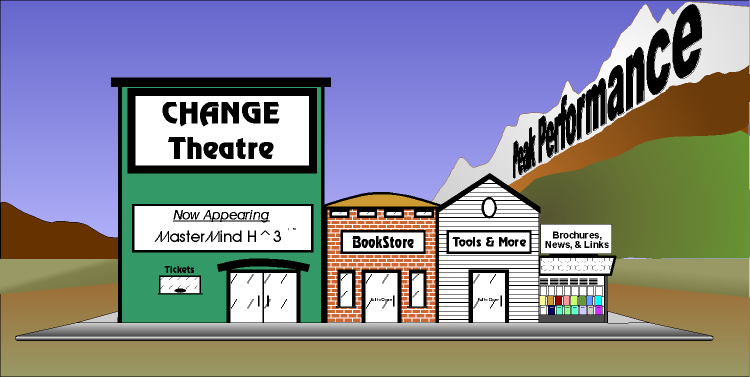Historical Perspective
Eventronics™, formed in March of 2002,
is dedicated to making real the application of Event Theory toward
helping its clients achieve increased income, reduced expenditures
and improved quality of life. With offices in East Aurora, New
York we provide client services across the globe. Eventronics™
delivers measurable results through products, workshops, client
mentoring and consulting services.
Eventronics™ is based on a revolutionary
observation. Just as electrons are foundational to the structure
and properties of matter, events function as the foundation of
all activity at any level of complexity. Without events, life
itself could not exist. This understanding forms the basis for
a world of discovery that we believe will come to dramatically
alter the world’s view of organizational and individual
dynamics.
Eventronics was founded by Michael
H. Spindelman, an accomplished businessman, engineer,
troubleshooter and entrepreneur. Growing up in a family-owned
retail business, Spindelman’s first exposure to the business
world came at age 13 during a Labor Day sale. On that day he earned
his first entrepreneurial dollar, in the process learning fundamental
selling strategies. His love for electronics developed shortly
afterwards during the production of a television commercial to
promote the store. He witnessed first-hand how technology was
able to seamlessly link short snippets of unrelated video clips
into a cohesive message.
Upon completing college Spindelman received a BSEE from Rochester
Institute of Technology, majoring in analog/digital systems with
a minor in business. He began his professional career at Hewlett-Packard
in the late '70's (a major recession period) as a field sales
engineer at the start of the mini and desktop computer era. (pre-PC)
He immediately recognized that desktop computing was going to
be the "Fractional Horsepower Engine" (the little marvel
that brought America out of the Depression) of the computational
age.
A good deal of Spindelman’s career was spent in the systems
development arena. He integrated custom-developed software applications
with complex components to create practical, seamless, real-world
systems to improve productivity for average individuals. He worked
in test engineering at Motorola during the beginning of the Quality
Movement, at Computer Consoles at the breakup of AT&T (in
directory assistance voice telephony A/D systems), and in design
engineering at Strippit/DiAcro developing emerging networked control
systems for machine tools (integrated manufacturing work cells).
The technical side of his work was always balanced by the human
aspects of whatever application he was working on. A coworker
once said that Spindelman could take innate objects and bring
life to them. Ergonomics was the foundation for everything from
test systems to hand-held applications. While working as a systems
integrator, he focused on how to apply Computer Aided Design Systems
to accelerate the concept-to-product (art-to-part) cycle.
It was at this time that Spindelman discovered that dramatic innovation
comes about when technology is not permitted to impede the stream
of its users’ thought process. During this period, too,
he realized that on top of the physical world around us is an
unseen layer of data that can be a major aid to progress if we
learn to interpret the feedback it offers us.
While helping a start-up Six Sigma consulting practice, Spindelman
provided $6M of the sales growth it achieved in growing from $280K
to nearly $10M over twenty-two months. But after-hours discussions
with key figures in some mature Six Sigma companies revealed a
glass ceiling they were all inevitably reaching. Something was
missing from the Six Sigma toolset.
These companies were also looking for a "universal"
methodology that would encompass and improve upon all of the "Flavor
of The Month" management initiatives. As 2001 began some
tech sector Six Sigma companies were getting smashed as the technology
bubble burst. Their programs could not solve one major problem
that proved decisive for them: how to create reliable top-line
income growth.
When there was room for cost reduction in an enterprise, Six Sigma
worked great. Six Sigma proceduralized everything from production
to the sales process, but the need for innovation to meet true
market demand just couldn't be addressed by process improvement.
To use an analogy, many companies were trying to sell sweaters
in a heat wave, and no one was buying. Then 9/11 hit. With the
downturn in the economy the problem spread like wildfire across
other industries. But where Six Sigma saw insurmountable problems,
Eventronics™ was beginning to see patterns.
In slightly technical terms, what Six Sigma did was what a good
television set designer would do. They got all of the operational
components of the system working. The focus was on throughput,
cycle time and scrap. They transformed an organization –
to continue the analogy – from rabbit ear reception to cable
clarity. But they never addressed the content of what was on the
display. And this ultimately brought about the failure of their
methodology.*
Meanwhile major industry players were adjusting from this mistake.
The computer industry had grown past selling just computers to
selling software and peripherals. Even HP finally realized there
was little money in printers, but lots of it in the consumables.
Apple computers tanked selling computers but soared selling desktop
publishing. Sony realized there was little money in TV's, radios,
and computers, and they learned quickly that there is lots of
money to be made in entertainment. The lesson was and is: Control
both the hardware and the software, the technology and the content,
and you can drive future growth.
Spindelman’s goal in developing Eventronics™ was
to improve both process and content. In the terms of Event Theory,
which he developed to support this work, this requires viewing
the events and not just the moments, focusing on the flow of the
entire movie instead of individual snapshots. Spindelman essentially
created a science of individual and organizational effectiveness
that responds to a continuously fluctuating field of market dynamics.
With the MasterMind H3 program we believe we have
succeeded to a degree that no other business improvement program
has in systematizing ALL the elements of a successful and sustainable
business at any scale: innovation, project fulfillment and organizational
synergy .
For more on Event Theory go to Here.
For the content of the MasterMind H3 go to Here.
To see the benefits you and your organization can expect to gain
go to Here.
*In engineering terms, T(s), where T is a transfer
function and s represents the domain of the system, equals the
sum of all F(x), where each F is a process and x the elements
of that process, PLUS some other terms that Six Sigma neglected
to include in their equation. The Event Flow™ model defines
these other terms as Ideas and Work. By ignoring these other terms
Six Sigma alone was not able to produce a truly comprehensive
organizational transfer function.
|
 History
Of Eventronics™ in East Aurora, NY
History
Of Eventronics™ in East Aurora, NY
